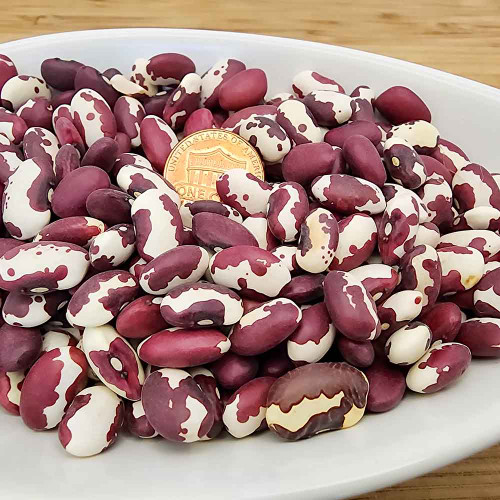Tendergreen Bush Bean Seeds - (Phaseolus vulgaris)
- SKU:
- V1323
- Seed Count:
- Approx 50 seeds per pack
- Days to Maturity:
- 45-57 days
- Type:
- Bush
- Days to Germination:
- 3-7 days @ 60-85F
- Plant Spacing:
- 3-4"
- Light Preference:
- Full sun
- Soil Requirements:
- Well drained
- Status:
- Heirloom, Non-Hybrid, Non-GMO seeds
Description
Tendergreen Bush Bean- The Benchmark for Stringless Bush Bean
For nearly 100 years, gardeners have relied on the Tendergreen bush bean for its consistent performance and classic flavor. Its excellence was recognized early with an All-America Selections award in 1933, solidifying its place as a valuable heirloom following the "stringless revolution." What keeps gardeners coming back is its straightforward dependability: sturdy, self-supporting bush plants yield abundantly without fuss, offering truly stringless, tender-crisp pods even when summer temperatures climb, backed by notable resistance to Common Bean Mosaic Virus. It remains a trusted choice for uncomplicated, flavorful green bean harvests season after season.
Details
A trusted favorite known simply as Tendergreen or Tendergreen Stringless, this bush bean has been relied upon by generations of American home gardeners for its consistent performance. It grows as an annual, forming sturdy, upright, self-supporting plants typically reaching 18-22 inches tall with a spread of 12-24 inches, making it well-suited for rows, raised beds, or containers without needing stakes.
The plants produce abundant yields of round, straight, completely stringless pods measuring 5-7 inches long (most commonly 5-6 inches). These appealing medium-dark green pods sometimes show faint purple flecks that vanish when cooked. They are prized for their meaty and exceptionally tender quality, offering a satisfying crisp, smooth texture.
Expect the first snap bean harvest approximately 50-60 days from planting in warm soil (use pod appearance as the best guide). Tendergreen thrives across USDA Zones 3-12 and is notably heat-tolerant and resistant to Common Bean Mosaic Virus (CBMV), adding to its reliability.
History
The common bean, Phaseolus vulgaris, is native to the Americas and is one of the world's oldest food crops, with domestication dating back thousands of years in both Mesoamerica and the Andean region. Beans formed a crucial part of indigenous agricultural systems, famously as one of the "Three Sisters" alongside corn and squash, providing essential protein and enriching the soil through nitrogen fixation.
While the common bean itself is ancient, the story of convenient, stringless snap beans took off in the late 1800s with the groundbreaking work of Calvin Keeney, often referred to as the "father of the stringless bean." Tendergreen followed shortly after. While some sources link its arrival to 1925 and Keeney himself, the most verifiable accounts, including correspondence from the company, indicate that it was introduced around 1922 by Peter Henderson & Co. However, its exact parentage remains officially unknown. Regardless of the precise origin details, Tendergreen quickly gained prominence, capitalizing on the demand for stringless beans Keeney had fostered.
Its excellence was formally recognized with an All-America Selections (AAS) award in 1933. As a variety that predates modern hybrids, Tendergreen is rightly considered a valuable heirloom, representing nearly a century of reliable garden performance.
Uses
Tendergreen is a versatile, "all-purpose" bean, excelling primarily as a snap bean. Harvest pods young (5-6 inches) when firm and crisp for the best flavor and texture. Flavor descriptions include tasty, mild, sweet, nutty, rich, and fresh, offering a distinctive classic bean taste. Their stringless nature makes preparation easy for eating raw in salads or for quick cooking via steaming, sautéing, roasting, or grilling. It's also an excellent variety for preserving, holding its quality well whether canned or frozen, and suitable for pickling ("dilly beans"). Beyond snap use, pods can be left to mature longer for fresh shelling beans, or allowed to dry completely on the vine for harvesting as a flavorful dry bean for soups and baked dishes.
Tendergreen beans pair well with fresh herbs such as thyme, rosemary, tarragon, and basil; citrus; nuts like walnuts, almonds, and pine nuts; raisins; cheeses such as cheddar, mozzarella, and gouda; tomatoes; mushrooms; potatoes; and summer squash.
Companion Planting
As legumes, Tendergreen beans enrich the soil through nitrogen fixation, benefiting nearby heavy feeders like corn or leafy greens. Planting low-growing annuals at their base can help keep roots cool.
Avoid planting beans directly next to Alliums (onions, garlic) or Fennel. Ensure good air circulation between plants for overall health.
Planting and Growing Tips
Success relies on planting this warm-season annual after all danger of frost when soil is warm, ideally 65-85°F (minimum 60°F). Choose a site with full sun (6+ hours daily). They demand rich, fertile, well-drained soil; amending with compost is highly recommended. Afternoon shade can help production during the summer in hot weather climates. Direct sowing is preferred. Plant seeds 1-1.5 inches deep, spaced 3-4 inches apart in rows 18-24 inches apart. Water lightly after sowing; germination takes 3-7 days in warm soil.
Water consistently, especially during flowering/pod set (1-2 inches/week), watering at the soil level. These beans are relatively light feeders; use low-nitrogen fertilizer sparingly only if needed early on. Keep young plants weeded; mulch helps conserve moisture and suppress weeds. No staking is required for this bush type. For a continuous supply, practice succession planting every 2-3 weeks until 8-10 weeks before the first fall frost; Tendergreen's heat tolerance handles mid-summer sowing well.
Harvesting Tips
Harvest snap beans frequently (every 1-3 days) when pods are firm, crisp, smooth, and pencil-thick (typically 5-6 inches), before the seeds inside swell noticeably. They should snap cleanly. Pick gently in the morning after dew dries, supporting the plant. Consistent harvesting acts as deadheading and encourages the plant to produce more pods. For dry beans, leave pods on the plant until fully dry and brittle, then harvest before they shatter, dry further if needed, shell, and store.
Learn More
From the soil to the seed to the food you eat - we'll help you grow your best garden!













